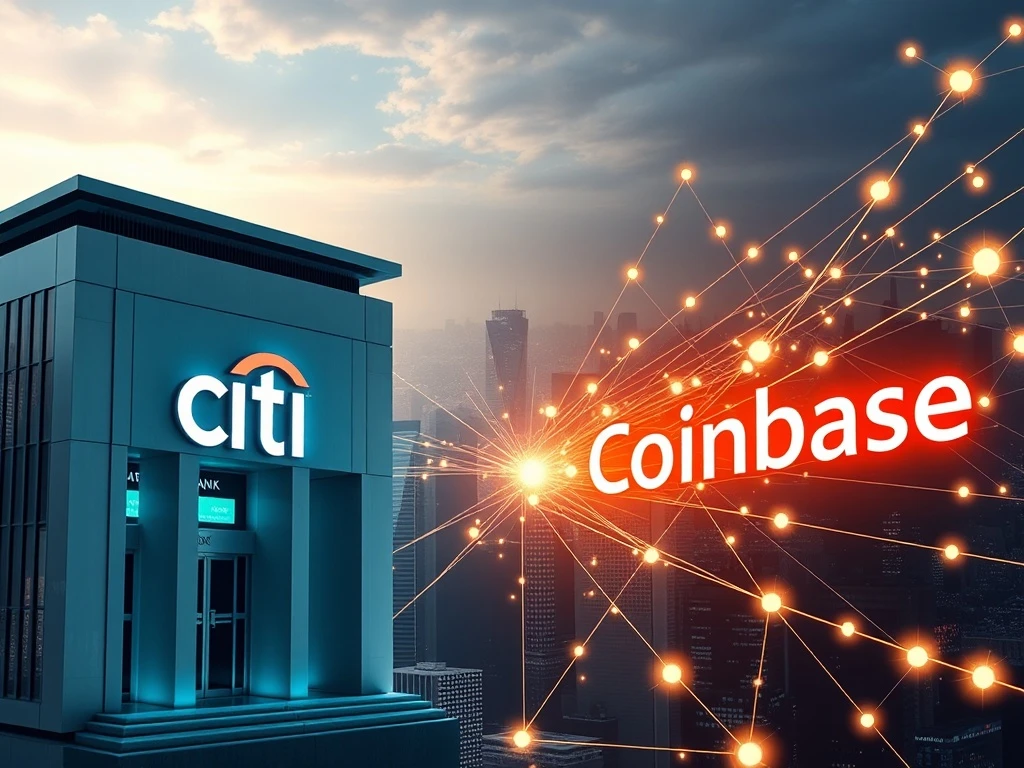Citi Stablecoin Payments: Pioneering a Trillion-Dollar Digital Future with Coinbase

The financial world stands on the cusp of a major transformation. Traditional banking giants are now embracing digital assets. This shift is particularly evident with a groundbreaking development. Citi, a global banking powerhouse, is forging a significant alliance. They are partnering with leading crypto exchange Coinbase. This collaboration aims to pilot Citi stablecoin payments, marking a pivotal moment. It signifies Wall Street’s accelerating integration of cryptocurrencies into mainstream finance. For anyone tracking the evolution of digital money, this news is truly monumental.
Citi Stablecoin Payments: A Landmark Partnership with Coinbase
Citigroup is positioning itself as a pioneer. It could become one of Wall Street’s first major banks to offer stablecoin payment services. This move represents a potential milestone for tokenized dollars. The recently passed GENIUS Act earlier this year underpins this development. According to Bloomberg, Citi has teamed up with Coinbase. This collaboration will expand Citi’s digital asset capabilities. Their initial focus is clear. They want to simplify fund transfers for clients. Clients can move money between fiat currencies and crypto more easily.
Debopama Sen, Citi’s head of payments, highlighted client demands. She stated that clients seek programmability, conditional payments, and greater speed. They also desire round-the-clock payment access. Consequently, Citi is actively “exploring solutions.” These solutions will enable onchain stablecoin payments for their clients very soon. Sen emphasized the role of stablecoins. She said, “Stablecoins will be another enabler in the digital payment ecosystem.” Furthermore, she believes they will help grow the space and enhance functionality for clients. This strategic Coinbase partnership underscores Citi’s commitment to innovation.
Unlocking the $4 Trillion Stablecoin Market Forecast
Citi’s strong emphasis on stablecoins is hardly surprising. Recent developments align with their revised market outlook. Just last month, the bank significantly raised its forecast. They now estimate the stablecoin market could reach a staggering $4 trillion by 2030. This is a dramatic increase from its current size. Today, the market sits at approximately $315 billion. The growth trajectory has been remarkable. The stablecoin market expanded from under $5 billion in early 2020 to over $315 billion today. This explosive growth signals a powerful trend. It highlights the increasing utility and demand for digital dollars.
This revised stablecoin market forecast by Citi reflects a growing institutional confidence. Banks recognize the immense potential. Stablecoins offer efficiency and speed. They also provide transparency in transactions. Therefore, they are becoming an indispensable tool in modern finance. The market’s expansion is not just about volume. It is about integrating digital assets into daily financial operations. This integration promises to reshape global payment systems.
The GENIUS Act: Driving Wall Street Crypto Adoption
The passage of the U.S. GENIUS Act has created a new urgency. This legislation establishes a clear regulatory framework for stablecoins. It takes effect in early 2027. Consequently, major banks are now exploring their own stablecoin initiatives. Citigroup is part of a growing cohort of Wall Street institutions. This group includes financial giants like JPMorgan and Bank of America. They are all in the early stages of developing stablecoin-related services. Even Jamie Dimon, JPMorgan’s CEO and a longtime crypto skeptic, has shifted his stance. He recently informed shareholders that the bank “plans to be involved” in stablecoin development. This marks a significant pivot for a prominent figure in traditional finance.
The regulatory clarity provided by the GENIUS Act is crucial. It offers a secure environment for banks to operate. This framework mitigates risks and fosters innovation. It accelerates Wall Street crypto adoption. Banks can now confidently invest in digital asset infrastructure. They can also develop compliant stablecoin products. This legislative support paves the way for broader institutional engagement. It ensures that tokenized dollars can integrate seamlessly into the existing financial system.
Investor Enthusiasm Fuels Stablecoin Growth
Investor enthusiasm is also rising. This trend mirrors the increasing institutional interest. Circle, the issuer of USDC (USDC), exemplifies this growth. USDC is the world’s second-largest dollar-pegged stablecoin. Circle went public earlier this year. Its debut was a blockbuster event. The stock surged an impressive 167% on its first trading day. Circle currently boasts a market capitalization of around $35 billion. This successful IPO underscores investor confidence. It shows belief in the future of regulated stablecoins. Furthermore, it highlights the demand for transparent and secure digital assets.
Beyond traditional stablecoins, new financial products are emerging. Tokenized money market funds are gaining traction. These offerings provide another avenue for institutional participation. They bridge the gap between conventional finance and digital assets. This innovation attracts a diverse range of investors. It expands the stablecoin ecosystem significantly. Ultimately, the robust investor interest reinforces the long-term viability and growth potential of this market segment.
Future Implications of the Coinbase Partnership
The partnership between Citi and Coinbase holds vast implications. It will likely redefine how institutions handle digital payments. This collaboration moves beyond mere experimentation. It signifies a tangible step towards operationalizing stablecoins for corporate clients. Citi’s extensive global network combined with Coinbase’s crypto expertise creates a powerful synergy. Clients will benefit from faster, more efficient, and programmable payment solutions. This will enhance their financial operations globally.
Ultimately, this initiative could set a new standard. It demonstrates how traditional banks can leverage blockchain technology. The goal is to meet evolving client needs. This is not just about stablecoins. It is about building a more interconnected and efficient financial future. Citi’s move with Coinbase confirms that digital assets are no longer fringe. They are integral to the future of finance. This pioneering step paves the way for widespread adoption of tokenized dollars across the financial landscape.








